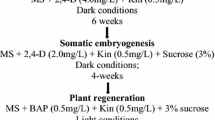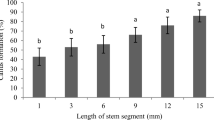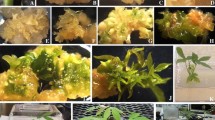Summary
A procedure for the regeneration of cacao (Theobroma cacao) plants from staminode explants via somatic embryogenesis was developed. Rapidly growing calli were induced by culturing staminode explants on a DKW salts-based primary callus growth (PCG) medium supplemented with 20 g glucose per L, 9 μM 2,4-D, and thidiazuron (TDZ) at various concentrations. Calli were subcultured onto a WPM salts-based secondary callus growth medium supplemented with 20 g glucose per L, 9 μM 2,4-D, and 1.4 nM kinetin. Somatic embryos were formed from embryogenic calli following transfer to a hormone-free DKW salts-based embryo development medium containing sucrose. The concentration of TDZ used in PCG medium significantly affected the rate of callus growth, the frequency of embryogenesis, and the number of somatic embryos produced from each responsive explant. A TDZ concentration of 22.7 nM was found to be the optimal concentration for effective induction of somatic embryos from various cacao genotypes. Using this procedure, we recovered somatic embryos from all 19 tested cacao genotypes, representing three major genetic group types. However, among these genotypes, a wide range of variation was observed in both the frequency of embryogenesis, which ranged from 1 to 100%, and the average number of somatic embryos produced from each responsive explant, which ranged from 2 to 46. Two types of somatic embryos were identified on the basis of their visual appearance and growth behavior. A large number of cacao plants have been regenerated from somatic embryos and established in soil in a greenhouse. Plants showed morphological and growth characteristics similar to those of seed-derived plants. The described procedure may allow for the practical use of somatic embryogenesis for clonal propagation of elite cacao clones and other applications that require the production of a large number of plants from limited source materials.
Similar content being viewed by others
References
Alemanno, L.; Berthouly, M.; Michaux-Ferriere, N. Embryogenése somatique du cacaoyer á partir de pièces florales. Plant. Rech. Dev. 3:225–233; 1996a.
Alemanno, L.; Berthouly, M.; Michaux-Ferriere, N. Histology of somatic embryogenesis from floral tissues cocoa. Plant Cell Tissue Organ Cult. 46:187–194; 1996b.
Arndt, F.; Rusch, R.; Stilfried, H. V. SN49537, a new cotton defoliant. Plant Physiol. 57:99; 1976.
Duncan, D. B. Multiple range and multiple F-test. Biometrics 11:1–42; 1955.
Driver, J. A.; Kuniyuki, A. H. In vitro propagation of Paradox walnut rootstock. HortScience 19:507–509; 1984.
Esan, E. B. Tissue culture studies on cacao (Theobroma cacao L.). A supplementation of current research. In: Proc. 5th Int. Cacao Res. Conf. 1975. Ibadan: Cacao Res. Inst. Nigeria; 1977:116–125.
Esan, E. B. Micropropagation of cacao (Theobroma cacao L.). In: Bajaj, Y. P. S., ed. Biotechnology in agriculture and forestry. Vol. 18. High-tech and micropropagation II. Berlin Heidelberg, New York: Springer-Verlag; 1992: 96–122.
Figueira, A.; Janick, J. Development of nucellar somatic embryos ofTheobroma cacao. Acta Hortic. 336:231–236; 1993.
Figueira, A.; Janick, J. Optimizing carbon dioxide and light levels during in vitro culture ofTheobroma cacao. J. Am. Soc. Hortic. Sci. 119:865–871; 1994.
Figueira, A.; Janick, J. Somatic embryogenesis in cacao (Theobroma cacao L.). In: Jain, S.; Gupta, P.; Newton, R., ed. Somatic embryogenesis in woody plants. Vol. 2. The Netherlands: Kluwer Academic Publisher; 1995:291–310.
Flynn, W. P.; Glicenstein, L. J.; Fritz, P. J.Theobroma cacao L.: an axillary bud in vitro propagation procedure. Plant Tissue Organ Cult. 20:111–117; 1990.
Gamborg, O. E. Aromatic metabolism in plants. II. Enzymes of the shikimate pathway in suspension cultures of plant cells. Can. J. Biochem. 44:791–799; 1966.
Gill, R.; Saxena, P. K. Direct somatic embryogenesis and regeneration of plants from seedling explants of peanut (Arachis hypogaea) promotive role of thidiazuron. Can. J. Bot. 70:1186–1192; 1992.
Gray, D. J.; McColley, D. W.; Compton, E. High-frequency somatic embryo-genesis from quiescent seed cotyledons ofCucumis melo cultivars. J. Am. Soc. Hortic. Sci. 118:425–432; 1993.
Huetteman, C. A.; Preece, J. E. Thidiazuron: a potent cytokinin for woody plant tissue culture. Plant Cell Tissue Organ Cult. 33:105–119; 1993.
Kennedy, A. J.; Lockwood, G.; Mossu, G., et al. Cacao breeding: past, present, and future. Cocoa Grower’s Bull. 38:5–22; 1987. Cadbury Schweppes, Birmingham, UK.
Lerceteau, E.; Robert, T.; Pétiard, V., et al. Evaluation of the extent of genetic variability amongTheobroma cacao accessions using RAPD and RFLP markers. Theor. Appl. Genet. 95:10–19; 1997.
Lloyd, G.; McCown, B. Commercially feasible micropropagation of Mountain Laurel,Kalmia latifolia, by use of shoot-tip culture. Proc. Int. Plant Prop. Soc. 30:421–427; 1980.
Lopez-Baez, O.; Bollon, H.; Eskes, A., et al. Embryogenèse somatique de cacaoyerTheobroma cacao L. á partir de pièces florales. C. R. Acad. Sci. Paris 316:579–584; 1993.
Lu, C. Y., The use of thidiazuron in tissue culture. In Vitro Cell. Dev. Biol. 29:92–96; 1993.
Mok, M. C.; Mok, D. W. S.; Armstrong, D. J., et al. Cytokinin activity of N-phenyl-N′-1,2,3-thiadiazol-5-yl urea (thidiazuron). Phytochemistry 21:1509–1511; 1982.
Mok, M. C.; Mok, D. W. S.; Turner, J. E., et al. Biological and biochemical effects of cytokinin-active phenylurea derivatives in tissue culture systems. HortScience 22:1194–1197; 1987.
Murashige, T.; Skoog, F. A revised medium for rapid growth and bioassays with tobacco tissue cultures. Physiol. Plant. 15:473–497; 1962.
Murch, S. J.; KrishnaRaj, S.; Saxena, P. K. Thidiazuron-induced morphogenesis of Regal geranium (Pelargonium domesticum): a potential stress response. Physiol. Plant. 101:183–191; 1997.
Orchard, J. E.; Collin, H. A.; Hardwick, K. Culture of shoot apices ofTheobroma cacao. Physiol. Plant. 47:207–210; 1979.
Passey, A. J.; Jones, O. P. Shoot proliferation and rooting in vitro ofTheobroma cacao L. type Amelonado. J. Hortic. Sci. 58:589–592; 1983.
Pedroso, M. C.; Tavres, R.; Lino-neto, T., et al. Early events in somatic embryogenesis induction. In: Ahuja, M. R., et al., ed. Somatic cell genetics and molecular genetics of trees. The Netherlands: Kluwer Acad. Publishers; 1996:17–22.
Pence, V. C.: Cacao (Theobroma cacao L.). In: Bajaj, Y. P. S., ed. Biotechnology in agriculture and forestry. Vol. 5. Tree II. Berlin Heidelberg New York: Springer-Verlag; 1989:203–221.
Pence, V. C.; Hasegawa, P. M.; Janick, J. Asexual embryogenesis inTheobroma cacao L. J. Am. Soc. Hortic. Sci. 104:145–148; 1979.
Pence, V. C.; Hasegawa, P. M.; Janick, J. Initiation and development of asexual embryos ofTheobroma cacao L. in vitro. Z. Pflanzenphysiol. 98:1–14; 1980.
Sondahl, M. R.; Sereduk, T. B.; Chen, Z., et al. Somatic embryogenesis and plant regeneration of cacao, patent no. 88/3078, Jen 25, 1989. Republic of South Africa.
Sondahl, M. R.; Liu, S.; Bellato, C., et al. Cacao somatic embryogenesis. Acta Hortic. 336:245–248; 1993.
Suttle, J. C. Involvement of ethylene in the action of the cotton defoliant thidiazuron. Plant Physiol. 78:272–276; 1985.
Toxopeus, H. Botany, types and populations. In Wood, G. A.; Lass, R. A., ed. Cocoa. 4th edition. New York: Longman Scientific & Technical, and John Wiley & Sons, Inc.; 1985:11–37.
Tuleckle, W.; McGranahan, G. Somatic embryogenesis and plant regeneration from cotyledons of walnut,Juglans regia L. Plant Sci. 40:57–63; 1985.
Wakeling, S. A. Review of production, consumption, stocks and prices. Cocoa Growers’ Bulletin 50:3, 1996, Cadbury Schweppes, Birmingham, UK.
Wang, S. Y.; Steffens, G. L.; Faust, M. Breaking bud dormancy in apple with a plant bioregulator, thidiazuron. Phytochemistry 25:311–317; 1986.
Wang, Y. C.; Janick, J. Inducing precocious germination in asexual embryos of cacao. HortScience 19:839–841; 1984.
Wood, G. A. R.; Lass, R. A. Cocoa. 4th edition. New York: Longman Scientific & Technical and John Wiley & Sons, Inc.; 1987.
Author information
Authors and Affiliations
Rights and permissions
About this article
Cite this article
Li, Z., Traore, A., Maximova, S. et al. Somatic embryogenesis and plant regeneration from floral explants of cacao (Theobroma cacao L.) using thidiazuron. In Vitro Cell.Dev.Biol.-Plant 34, 293–299 (1998). https://doi.org/10.1007/BF02822737
Received:
Accepted:
Issue Date:
DOI: https://doi.org/10.1007/BF02822737




